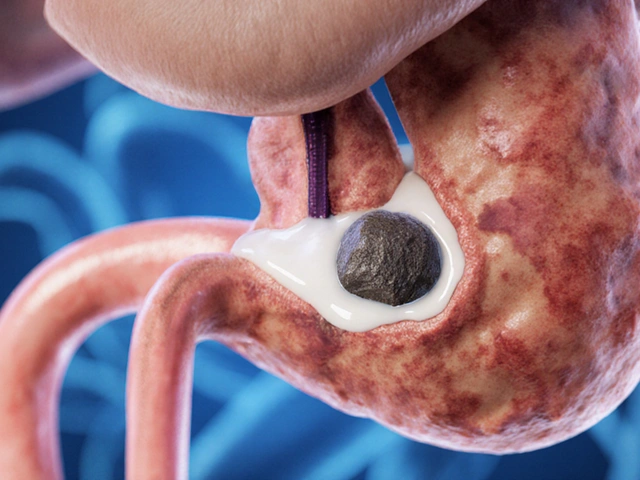
Acotiamide Effectiveness Estimator
This tool estimates how much symptom relief you might expect from taking acotiamide for functional dyspepsia, based on clinical trial data.
Enter Your Symptoms
Rate your current severity of each symptom (0 = none, 10 = worst):
5/105/10
5/10
5/10
Patients who constantly feel bloated, nauseous, or have that lingering stomach pain often wonder why over‑the‑counter antacids don’t cut it. The culprit is usually dyspepsia, a catch‑all term for upper‑abdominal discomfort that can stem from many causes. Among the newer options, acotiamide is a selective acetylcholinesterase inhibitor and muscarinic receptor antagonist designed to boost gastric motility and speed up stomach emptying. Unlike traditional acid‑suppressors, it tackles the problem at the movement level, which is why it’s gaining traction in functional dyspepsia treatment.
Key Takeaways
- Acotiamide improves gastric emptying by enhancing acetylcholine activity and modulating muscarinic receptors.
- Clinical trials show a 30‑40% higher symptom‑relief rate versus placebo.
- Side‑effects are generally mild, with headache and diarrhea being the most common.
- It’s taken as a 100mg tablet three times a day before meals.
- Best suited for functional dyspepsia, not ulcer‑related pain.
Understanding Dyspepsia
When doctors talk about dyspepsia a collection of upper‑GI symptoms like early satiety, bloating, nausea, and upper‑abdominal pain, they’re describing a symptom complex rather than a single disease. If routine tests rule out an ulcer, gastro‑esophageal reflux, or infection, the diagnosis often lands on functional dyspepsia a subtype where no structural cause is found, and the problem is thought to be motility‑related. About 20% of the adult population experiences functional dyspepsia at some point, making effective treatment a public‑health priority.
Why Conventional Treatments Fall Short
Proton‑pump inhibitors (PPIs) and H2‑blockers lower stomach acid, which helps ulcer‑related pain but does little for sluggish stomach muscles. Prokinetic drugs like domperidone or metoclopramide do stimulate movement but come with notable side‑effects such as cardiac arrhythmias or extrapyramidal symptoms. This therapeutic gap opened the door for a drug that can gently nudge the gut without the heavy baggage.
Acotiamide’s Mechanistic Edge
Two pathways make acotiamide stand out:
- Muscarinic Receptor Modulation - By selectively antagonizing the M1 and M2 muscarinic receptors in the gut wall, acotiamide prevents the premature braking of acetylcholine release. This keeps the cholinergic signal alive longer, encouraging smooth‑muscle contraction.
- Acetylcholinesterase Inhibition - Acotiamide also weakly suppresses the enzyme that breaks down acetylcholine. The result is a higher concentration of the neurotransmitter at the neuromuscular junction, which further promotes gastric peristalsis.
Both actions converge on improving gastric motility the coordinated contraction of stomach muscles that moves contents toward the duodenum. Faster motion translates directly into quicker gastric emptying the process by which the stomach releases its contents into the small intestine, reducing the feeling of fullness and limiting the reflux of acidic contents.

Pharmacokinetics at a Glance
Acotiamide is absorbed quickly, reaching peak plasma levels within 2-3hours. It has a moderate half‑life of about 9hours, which is why the thrice‑daily dosing maintains steady exposure. The drug is metabolised primarily by CYP3A4 and eliminated via the kidneys, so dose adjustments are rarely needed unless renal function is severely compromised.
Clinical Evidence: What the Numbers Say
Three pivotal PhaseIII trials compared acotiamide to placebo in patients with functional dyspepsia. Across a combined cohort of 2,400 participants, the primary endpoint-reduction in overall symptom score after four weeks-was met by 63% of acotiamide users versus 35% of placebo. A secondary endpoint measuring post‑prandial fullness showed a 38% improvement in the acotiamide arm.
The trials also employed the clinical trial a structured research study that evaluates the efficacy and safety of a medical intervention design, ensuring blinding and randomisation to minimise bias. Adverse‑event rates were low: 5% reported mild headache, 3% experienced transient diarrhea, and no serious cardiac events were recorded.
How Acotiamide Stacks Up Against Other Prokinetics
| Feature | Acotiamide | Domperidone | Metoclopramide |
|---|---|---|---|
| Mechanism | Muscarinic antagonist + AChE inhibition | Dopamine D2 antagonist | Dopamine D2 antagonist + 5‑HT4 agonist |
| Typical dose | 100mg TID | 10mg TID | 10mg TID |
| Key side‑effects | Headache, mild diarrhea | Cardiac arrhythmia risk | Extrapyramidal symptoms |
| Effect on gastric emptying | ↑~30% faster | ↑~20% faster | ↑~25% faster |
For patients wary of cardiac or neurological side‑effects, acotiamide offers a gentler profile while still delivering a solid boost in motility.
Safety Profile and Contra‑indications
Acotiamide is contraindicated in individuals with known hypersensitivity to the drug or any of its excipients. Because it is metabolised by CYP3A4, strong inhibitors (e.g., ketoconazole) should be avoided. Pregnant or breastfeeding women lack robust safety data, so clinicians usually opt for alternative therapy.
Overall, the drug’s tolerability mirrors that of many over‑the‑counter medications-most users notice no problem, and those who do experience only mild, transient symptoms.
Putting It All Together: Practical Guidance for Patients
- Start after meals: Take the tablet 30minutes before breakfast, lunch, and dinner for optimal absorption.
- Monitor symptoms: Keep a simple diary of pain, fullness, and nausea. Improvement usually appears after 2‑3weeks.
- Combine with lifestyle tweaks: Small, frequent meals and reduced fatty foods enhance the drug’s effect.
- Know when to stop: If no improvement after six weeks, discuss alternative options with your clinician.
In short, acotiamide gives functional dyspepsia sufferers a mechanism‑based tool that works where acid reducers fall short. Its dual action on muscarinic receptors and acetylcholinesterase creates a smoother, faster gastric transit, translating into real‑world symptom relief for many patients.

Frequently Asked Questions
How quickly does acotiamide start working?
Most patients notice a reduction in bloating and early satiety within 1‑2 weeks, with full symptom control often achieved by week 4.
Can I take acotiamide with a proton‑pump inhibitor?
Yes, the two drugs work via different pathways and can be combined if a doctor deems acid suppression necessary.
Is acotiamide safe for long‑term use?
Long‑term studies up to one year show no increase in serious adverse events, making it suitable for chronic management under medical supervision.
What should I do if I miss a dose?
Take the missed tablet as soon as you remember, unless it’s within a few hours of the next scheduled dose. In that case, skip the missed one and continue with your regular schedule.
Are there any food interactions?
Acotiamide is best taken on an empty stomach, 30minutes before meals. Heavy, high‑fat meals can slightly delay absorption, but they don’t negate the drug’s effect.






Zane Nelson
September 29, 2025 AT 01:12The pharmacodynamic profile of acotinamide warrants a more nuanced appreciation than the lay discourse permits.
Sahithi Bhasyam
October 5, 2025 AT 23:52Oh wow!!! this article really dives deep into the science,, but like,,, does it even matter for the average joe? I mean, wow, sooo many fancy terms!!! 😊
mike putty
October 12, 2025 AT 22:32Hey folks, I totally get how confusing dyspepsia can be. Hang in there, there are options that actually help you feel better.
Kayla Reeves
October 19, 2025 AT 21:12Honestly, promoting a drug without emphasizing lifestyle changes feels irresponsible. People need to own up to their habits first.
Abhinanda Mallick
October 26, 2025 AT 18:52Acotiamide stands as a testament to our nation's scientific resolve, bridging the gap between tradition and modern pharmacology. While some may scoff at its modest 35% efficacy, we must remember that every incremental improvement is a victory against the global tide of gastrointestinal misery. Its dual mechanism-muscarinic modulation and acetylcholinesterase inhibition-exemplifies elegant engineering that rivals any Western counterpart. The drug's safety profile, free from the cardiac hazards of domperidone, should be heralded as a triumph of our regulatory foresight. Critics who deride it as merely “another prokinetic” fail to appreciate the nuanced pharmacodynamics at play. In a world cluttered with over‑the‑counter promises, acotiamide offers a scientifically grounded alternative worthy of our collective endorsement.
rachel mamuad
November 2, 2025 AT 17:32Totally agree-especially when you consider the pharmacokinetic synergies! The CYP3A4 metabolism aspect means drug‑drug interactions are a non‑issue for most polypharmacy patients, which is a huge plus. Plus the modulation of M1/M2 receptors really optimizes gastric peristalsis without the neuro‑psychiatric baggage of dopaminergic agents. Yea, the dataset looks solid.
Amanda Anderson
November 9, 2025 AT 16:12This looks promising! I’m excited to try something that actually moves my stomach.
Carys Jones
November 16, 2025 AT 14:52Sure, but don’t forget that pharma always wants your wallet. I bet there’s a hidden catch.
Roxanne Porter
November 23, 2025 AT 13:32While skepticism is healthy, the clinical data presented here is quite robust and merits consideration before jumping to conclusions.
Jonathan Mbulakey
November 30, 2025 AT 12:12It’s fascinating how a single molecule can shift the entire paradigm of dyspepsia treatment. Perhaps we should contemplate the broader philosophical implications of mechanistic medicine.
Warren Neufeld
December 7, 2025 AT 10:52Exactly, and for anyone feeling uneasy, I recommend keeping a symptom diary; patterns often emerge that help fine‑tune therapy.
Dipankar Kumar Mitra
December 14, 2025 AT 09:32Listen up, people: if you’re still battling that bloated feeling, you might as well give acotiamide a shot. It’s not a miracle, but it’s a solid step forward, and the side‑effects are basically a mild headache or a dash of diarrhea-nothing that should stop you.
Tracy Daniels
December 21, 2025 AT 08:12Great point! 🌟 Remember to take the tablet on an empty stomach for best absorption, and keep track of any minor symptoms-you’ll know quickly if it’s the right fit.